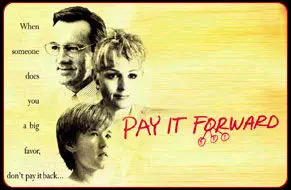Can YOU change
the world with a simple plan and a law of math?


This may seem like a ridiculous question, but it's answered in the book PAY IT FORWARD by Catherine Ryan Hyde Copyright 2000 Simon & Schuster.
PAY IT FORWARD is a story so real, that when you read it, or listen to it, or see it in the movie theater, you will believe it. It's the moving story about Trevor Mckinney, a twelve year old boy living in a small California town who accepts a bonus challenge from his social studies teacher. The challenge is to come up with a plan to change the world and put the plan into action.
The plan that Trevor comes up with is so simple, and naive, that when people hear about it they are negative, and tend to dismiss it as impossible. Even Trevor begins to doubt when his "pay it forward" plan appears to be not working. What he doesn't realize is that the math law of exponential growth is controlling his plan, and that kind of growth always starts out slow, and then EXPLODES.
What is his plan? Trevor chooses three people for whom he will do a big favor, and then when those people ask how they might pay him back, he will tell them that instead of paying it BACK, they are to "pay it FORWARD" by choosing three people for whom they can do favors, and in turn telling those people to pay it forward. It's quite simply a human chain letter of kindness and good will.
Well that's the plot line. Read below for a bit more of the story, then try the CAN IT HAPPEN CHALLENGE.
Story Synopsis:
The hero of this story is young Trevor McKinney, a 12-year-old whose imagination is sparked by an extra-credit assignment in Social Studies: "Think of an idea for world change, and put it into action."
Trevor's idea is deceptively simple: do a good deed for three people, and in exchange, ask each of them to "pay it forward" to three more. So nine people get helped. Then those people have to do three each for a total of twenty-seven.... Then it grows exponentially by powers of three.
Trevor's early attempts to get his project off the ground seem to end in failure: a junkie he befriends ends up back in jail; an elderly woman whose garden he tends dies unexpectedly. But even after the boy has given up on his plan, his acts of kindness bear unexpected fruit, and soon an entire movement is underway and spreading across America.
Trevor, meanwhile, could use a little help himself. His father walked out on the family, and his mother, Arlene, is fighting an uphill battle with alcoholism, poor judgment in men, and despair.
When the boy's new Social Studies teacher, Reuben St. Clair, arrives on the scene, Trevor sees in him not only a source of inspiration for how to change the world, but also the means of altering his mother's life.
Yet Reuben has his own set of problems. Horribly scarred in Vietnam, he is reluctant to open himself up to the possibility of rejection--or love. Indeed, the relationship between Arlene and Reuben is central to the novel as these two damaged people learn to "pay forward" the trust and affection Trevor has given them.
Hyde tells her tale from many different perspectives, using letters, diary entries, and first- and third-person narratives from the various people whose lives Trevor's project touches.
Jerry Busconi, for example, the addict Trevor tried to help, one night finds himself talking a young woman out of jumping off the Golden Gate Bridge:
I'm a junkie, Charlotte. I'm always gonna be a junkie. I ain't never gonna be no fine, upstanding citizen. But then I thought, hell. Just pay it forward anyway. Kid tried to help me. Okay, it didn't work. Still, I'm trying to help you. Maybe you'll jump. I don't know. But I tried, right? But let me tell you one thing. I woke up one morning and somebody gave me a chance. Just outta nowhere. It was like a miracle. Now, how do you know that won't happen to you tomorrow?
Your gonna have to see the movie or read, or listen to the book to see what how it ends. We don't want to spoil it for you here. Rest assured, it IS DEFINITELY WORTH YOUR TIME.
Here's the deal. Get out your calculator and a piece of paper. Get together with a group of friends and agree to try the "pay it forward" plan.
Figure out how long you want to give yourself to do your good deeds. We recommend a month. Then figure out how many deeds will grow from YOUR three by the end of a year,(12 months).
Once you know the impact that just YOU will make, then multiply that result by the number of people in your group. The results should amaze you.
Finally, once you know the mathematical implications, write down what it is you will do and name the three people you plan to help. Then go and do it. Remember, it might take a while to see the results because exponential growth starts out slowly, but we believe that your entire community can reap the benefits if you try.
Home | About
Us | Algebra| Dictionary | Games | Geometry | Gym | Humor | Lab | Magic | Natural Math | PreAlgebra | Resources | Teachers Only | Toolbox | Treasures | Videos | Wonders | Writings |
Copyright © 1999-2020 themathlab.com
